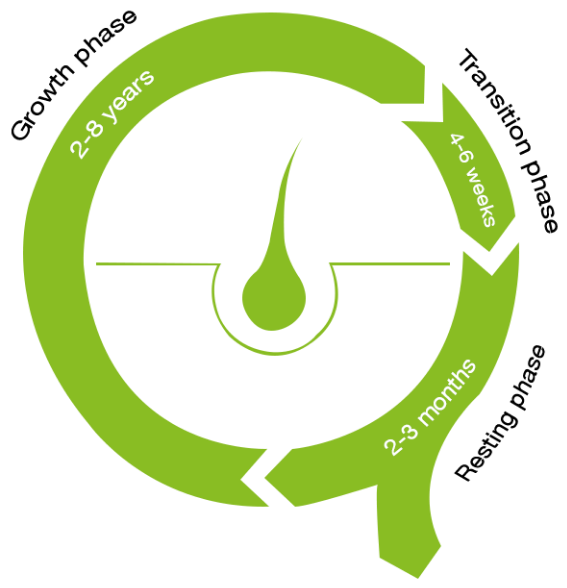About
How to Use
Priorin®L Liquid Formula needs to be applied directly on the scalp once daily any time during the day, using 1.5-2ml per application, which translates into 5-8 pumps. Apply by gently massaging the scalp. Priorin®L does not need to be rinsed off.16
Period of Use
Priorin®L Liquid Formula can be used in case of hair loss (not disease-related) for visibly denser and fuller appearing hair after three months.16
Key Ingredients
Priorin®L Liquid Formula contains the ingredient Baicapil™ which activates and enhances beautiful hair. Baicapil™ contains three botanical ingredients: scutellaria baicalensis root, soy (glycine soja) and wheat germ (triticum vulgare) extracts. Baicapil™ nourishes the scalp and results in hair that is healthier, thicker and more voluminous.16
Hair root and the three phases of hair growth.14

1. The Anagen Phase: A Time of Hair Growth
During the anagen phase, which is an important stage of the hair growth cycle, there is an increase in metabolic activity in the matrix cells located at the bottom of the hair follicle, just above the papilla. As a result of continual cell division, the bottom of the follicle is pushed deeper into the dermis.
New Hair Formation: New hair begins its growth process by the elongation of new cells, forming a thin filament. These cells then push their way upward into the follicular canal. Once inside the canal, these hair cells undergo differentiation and transform into the cuticle, cortex, and medulla. This transformation process marks the initiation of the keratinization process, which is essential for healthy hair.
In summary, the anagen phase is characterized by increased metabolic activity and the development of new hair cells, which undergo differentiation and become the various components of the hair strand

2. The Catagen Phase: A Transition in Hair Growth
After a period of active hair growth, which can vary depending on the type of hair, the hair follicle enters a brief transitional phase known as catagen. During this stage, cell division ceases, and the base of the hair shaft undergoes full keratinization, resulting in the formation of a dry, white node commonly referred to as a 'club' hair.
Changes in the Follicle: As the catagen phase progresses, the bulb of the hair starts to degenerate, and the follicle itself becomes significantly shorter. This phase marks a transition from active growth to a more dormant state.
In summary, the catagen phase represents a transitional period in the hair growth cycle. During this phase, cell division stops, the base of the hair shaft becomes fully keratinized, and the follicle experiences changes in its structure

3. The Telogen Phase: A Resting Period for Hair
After the transitional stage, the hair follicle enters a resting phase known as the telogen phase. During this period, the hair shaft ceases to grow and remains in the upper portion of the follicular canal. In this state, the hair can be easily removed by pulling.
Duration of the Telogen Phase: The length of time that follicles remain in the telogen phase varies depending on the body area and the individual's age. For scalp hair, the resting phase is relatively short, lasting about 10 weeks.
In summary, the telogen phase represents a period of rest for the hair follicle. During this phase, the hair shaft stops growing and remains in a state where it can be easily shed. The duration of this phase varies, with scalp hair typically having a relatively short resting period of approximately 10 weeks
Reference:
Harkey, M. R. (1992). Anatomy and physiology of hair. Forensic Science International, 63(1-3), 9–18. https://doi.org/10.1016/0379-0738(93)90255-9
**non-disease related




